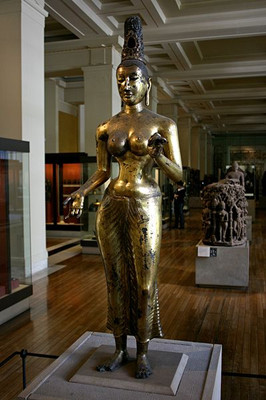We don't know who paid for Tara to be made. It could have been the ruler of any one of several kingdoms that squabbled and fought over territory in Sri Lanka around 800 AD. Whoever it was clearly wanted her help on the path to salvation. But in Sri Lanka, as anywhere else, gifts to religious institutions were also an important part of political strategies of rulers, a means of asserting their privileged links to the divine.
我們并不知道這位背后金主是誰。也許是公元八百年前后某位在斯里蘭卡為了領土征戰不休的國王,一個想要得到她拯救的人。斯里蘭卡的統治者和其他任何地方的一樣,將送禮物給宗教機構作為重要的政治策略,是他們對自己與神祇之間特權關系的公開展示。
One of the things that I find fascinating about this sculpture is that, at the time it was made, Tara was a relatively recent convert to Buddhism. She had originally been a Hindu mother goddess, and was only later adopted by Buddhists-a typical but particularly beautiful example of the constant dialogue and exchange between Buddhism and Hinduism that went on for centuries, and which can be seen today in statues and buildings all over south-east Asia. Tara shows that Buddhism and Hinduism are not tightly defined codes of belief, but ways of being and acting that can, in different contexts, absorb aspects of other faiths. Tara is, in modern parlance, a strikingly inclusive image made for a Buddhist, Sinhala-speaking, court in Sri Lanka, but stylistically part of the wider world that embraced the Tamil speaking, Hindu courts of southern India. Indeed Sri Lanka was shared, then as now, between Sinhala and Tamil, Hindu and Buddhist, and there were close links and many exchanges through diplomacy, marriage and, frequently, war.
有一點很有意思,這座雕像完工之時,度母剛剛為佛教所接納。她本是印度教的母親神,后來才開始被佛教徒信奉。佛教與印度教之間源 源不斷的交流與影響持續了數個世紀,至今仍能在東南亞各地的建筑與雕像中看出兩者交融的痕跡。度母便是其中典型又獨具魅力的例子。它表明,雖然佛教與印度教并不同宗同源,卻以各種形式汲取了對方的智慧。用現代的表述來說,度母就是一個令人驚嘆的兼容并包的形象:它由講僧伽羅語的斯里蘭卡宮廷中的佛教徒制作,但風格上更廣泛地融合了南印度講泰米爾語、信奉印度教的宮廷特色。直至今日,泰米爾語和僧伽羅語、印度教與佛教,仍共同占據著斯里蘭卡,它們通過外交、通婚,同時也通過頻繁的戰爭,彼此緊密聯系,廣泛交流。












